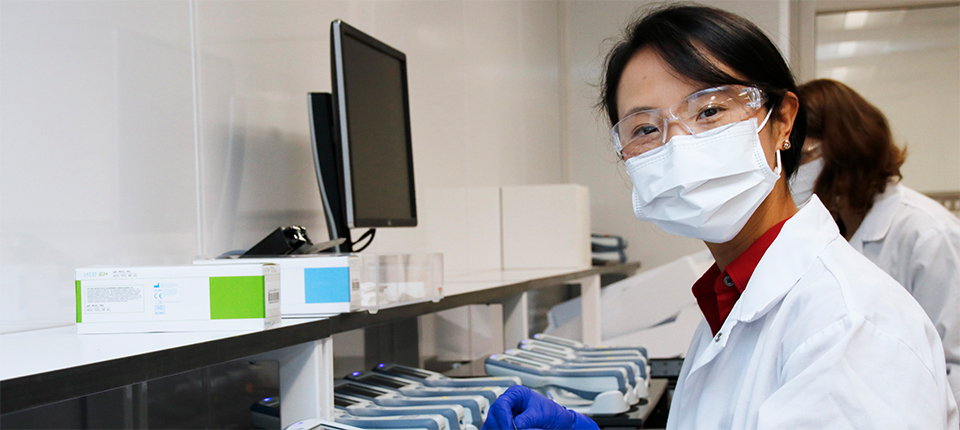
How abbott's point of care team problem solves for success in canada
Data-driven Lean Six Sigma helps Abbott's Point of Care team improve products and operations.
Dec. 21, 2021
- Copy Link
- Share on X
- Share on Facebook
- Share on Linkedin
Taking medical devices from concept to market is a complicated process that includes precision work and rounds of testing and regulatory approvals.
Abbott approaches this successfully with methodologies from Lean Six Sigma, a data-driven program focused on reducing waste that can be applied to all business operations, including manufacturing and supply chain.
Meghan Hawkes and Sally Liang, two Canada-based employees who work in Abbott's Point of Care Diagnostic business, spend much of their time anticipating and solving problems across the life cycles of Abbott products, including a handheld automated blood analysis system used at hospitals and urgent care facilities.

Dec. 21, 2021
Hawkes is a supervisor in Abbott's New Product Introduction team and Liang is a senior scientist in Research and Development. Both are based in Ottawa, Ontario. Among the products they have worked on are the i-STAT 1 and i-STAT Alinity Analyzer, a point of care device that uses a cartridge to analyze blood for a range of diagnostics tests including blood gases, chemistries, electrolytes, cardiac markers, pregnancy, brain injury, and coagulation.
Lean Six Sigma
Six Sigma was introduced in the 1980s at Motorola and expanded to Lean Six Sigma in the 2000s, when many Fortune 500 companies implemented it because it drives customer satisfaction while achieving financial benefits.
For Hawkes and Liang, Lean Six Sigma is the key to doing their jobs successfully. Both women are certified Six Sigma Black Belts, and they are part of a steering committee that strives to ensure the methodologies are deployed throughout the business. They also coach and train fellow employees working to achieve their various Six Sigma belt certifications. Hawkes and Liang say Lean Six Sigma has provided them with opportunities to apply critical thinking, develop problem solving skills, execute project management and demonstrate leadership.
While Hawkes and Liang use Lean Six Sigma principles in their day-to-day work, the steering committee takes a broader view to determine if there are opportunities to apply insights from one project to another. The committee uses a case-study approach to consider how solutions may transfer to other products or processes. The Lean Six Sigma program provides a unique opportunity for team members to learn and grow while delivering results, with the support of the management team.
Finding Efficiencies
In manufacturing, improving quality and minimizing waste and downtime are constant goals. Hawkes and Liang are charged with identifying and solving challenges when they arise, which was the case with a cartridge for the i-STAT blood analysis products.
The team initiated a Lean Six Sigma project to evaluate the sources of waste and inefficiency. Hawkes said they used several tools, including a time-lapse video, to observe the production floor. That footage helped pinpoint that operators' workstations were faced away from equipment, creating longer-than-necessary lags between equipment stoppage and human intervention.
Solutions included rearranging workstations to give equipment operators better lines of sight, adding red lights that would flash when machines shut down and identifying manual work that could be automated.
"Our teams were able to minimize the waste and make the process more efficient, which ultimately reduced the overtime and extra shifts," Hawkes said.
Inspiring Confidence
Employees not only use and apply Six Sigma methodologies to cultivate fast and effective solutions, but they also find the problem-solving process more engaging because they can try out-of-the-box approaches, Liang said.
Data-driven Lean Six Sigma processes are understood and proven effective, so they generate added confidence in the employees' work.
"It's about creating and manufacturing a product — one that has a significant impact on people's lives — that's consistent, reliable and of high quality for our customers. If you have satisfied customers, then they help you grow the business by investing in your product, and you can do more of these initiatives to improve even more," Hawkes said.
For the latest on Abbott’s life-changing technology, get updates directly in your inbox.